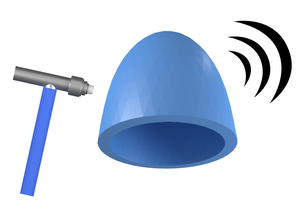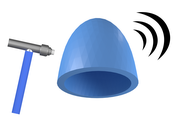Information
- Publication Type: Master Thesis
- Workgroup(s)/Project(s):
- Date: September 2015
- Date (Start): 30. January 2015
- Date (End): 21. September 2015
- First Supervisor:
- Keywords: physically based modeling, computer graphics, digital fabrication, 3D shape optmization, 3D shape processing
Abstract
Given a target shape and a target frequency, we automatically synthesize shapes that exhibit this frequency as part of their natural spectrum while resembling the target shape as closely as possible. We propose three shape parametrization methods that afford meaningful degrees of freedom in the design of instruments such as marimbas and bells. The design space is based on the representation of a solid as the volume enclosed by an outer surface and an inner offset surface. In order to evaluate the natural frequency spectrum of a solid, we employ finite element modal analysis and evaluate the suitability of different element types. We propose a fabrication method for the production of optimized instruments by an amateur craftsperson using sand or rubber molds. The efficiency of our method is demonstrated by the production of a simple tin bell and a more complicated bell in the shape of a rabbit. We achieve agreement with the predicted pitch frequencies of 2.8% and 6% respectively. These physical results are supplemented by a number of computational results that explore the optimization of harmonic ratios and the influence of mesh resolution and mesh smoothness on the accuracy of the finite element model.Additional Files and Images
Weblinks
No further information available.BibTeX
@mastersthesis{hafner-2015-eigf,
title = "Optimization of Natural Frequencies for Fabrication-Aware
Shape Modeling",
author = "Christian Hafner",
year = "2015",
abstract = "Given a target shape and a target frequency, we
automatically synthesize shapes that exhibit this frequency
as part of their natural spectrum while resembling the
target shape as closely as possible. We propose three shape
parametrization methods that afford meaningful degrees of
freedom in the design of instruments such as marimbas and
bells. The design space is based on the representation of a
solid as the volume enclosed by an outer surface and an
inner offset surface. In order to evaluate the natural
frequency spectrum of a solid, we employ finite element
modal analysis and evaluate the suitability of different
element types. We propose a fabrication method for the
production of optimized instruments by an amateur
craftsperson using sand or rubber molds. The efficiency of
our method is demonstrated by the production of a simple tin
bell and a more complicated bell in the shape of a rabbit.
We achieve agreement with the predicted pitch frequencies of
2.8% and 6% respectively. These physical results are
supplemented by a number of computational results that
explore the optimization of harmonic ratios and the
influence of mesh resolution and mesh smoothness on the
accuracy of the finite element model.",
month = sep,
address = "Favoritenstrasse 9-11/E193-02, A-1040 Vienna, Austria",
school = "Institute of Computer Graphics and Algorithms, Vienna
University of Technology ",
keywords = "physically based modeling, computer graphics, digital
fabrication, 3D shape optmization, 3D shape processing",
URL = "https://www.cg.tuwien.ac.at/research/publications/2015/hafner-2015-eigf/",
}

 poster
poster

